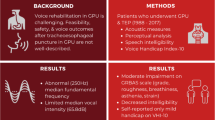Abstract
Purpose
To characterize outcomes of total laryngectomy for the dysfunctional larynx after radiation.
Methods
Retrospective case series of all subjects who underwent total laryngectomy for the irradiated dysfunctional larynx between 2000 and 2018 at an NCI-designated comprehensive cancer center at a single tertiary care academic medical center. Main outcomes included enteral tube feeding dependency, functional tracheoesophageal speech, and number and timing of postoperative pharyngeal dilations.
Results
Median time from radiation to laryngectomy was 2.8 years (range 0.5–27 years). Functional outcomes were analyzed for the 32 patients with 1-year follow-up. Preoperatively, 81% required at least partial enteral tube feeding, as compared to 34% 1-year postoperatively (p = 0.0003). At 1 year, 81% had achieved functional tracheoesophageal speech, which was associated with cricopharyngeal myotomy (p = 0.04, HR 0.04, 95% CI 0.002–0.949). There were 34% of subjects who required at least one pharyngeal dilation for stricture by 1 year postoperatively. Over half (60%) of the cohort were dilated over the study period.
Conclusions
Laryngectomy for the dysfunctional larynx improves speech and swallowing outcomes in many patients. Cricopharyngeal myotomy is associated with improved postoperative voice. While the need for enteral feeding is decreased, persistent postoperative swallowing dysfunction is common. Careful patient selection and education regarding functional expectations are paramount.


Similar content being viewed by others
References
Department of Veterans Affairs Laryngeal Cancer Study G, Wolf, GT, Fisher, SG, Hong, WK, Hillman, R, Spaulding, M, Laramore, GE, Endicott, JW, McClatchey, K, Henderson, WG (1991) Induction chemotherapy plus radiation compared with surgery plus radiation in patients with advanced laryngeal cancer. N Engl J Med 324(24):1685–1690. https://doi.org/10.1056/NEJM199106133242402
Forastiere AA, Goepfert H, Maor M, Pajak TF, Weber R, Morrison W, Glisson B, Trotti A, Ridge JA, Chao C, Peters G, Lee DJ, Leaf A, Ensley J, Cooper J (2003) Concurrent chemotherapy and radiotherapy for organ preservation in advanced laryngeal cancer. N Engl J Med 349(22):2091–2098. https://doi.org/10.1056/NEJMoa031317
Allen CT, Lee CJ, Merati AL (2013) Clinical assessment and treatment of the dysfunctional larynx after radiation. Otolaryngol Head Neck Surg 149(6):830–839. https://doi.org/10.1177/0194599813503802
Patterson JM, McColl E, Carding PN, Wilson JA (2018) Swallowing beyond six years post (chemo)radiotherapy for head and neck cancer; a cohort study. Oral Oncol 83:53–58. https://doi.org/10.1016/j.oraloncology.2018.06.003
Xu B, Boero IJ, Hwang L, Le QT, Moiseenko V, Sanghvi PR, Cohen EE, Mell LK, Murphy JD (2015) Aspiration pneumonia after concurrent chemoradiotherapy for head and neck cancer. Cancer 121(8):1303–1311. https://doi.org/10.1002/cncr.29207
Cannon CR, McLean WC (1982) Laryngectomy for chronic aspiration. Am J Otolaryngol 3(2):145–149
Hawthorne M, Gray R, Cottam C (1987) Conservative laryngectomy (an effective treatment for severe aspiration in motor neurone disease). J Laryngol Otol 101(3):283–285
Theunissen EA, Timmermans AJ, Zuur CL, Hamming-Vrieze O, Paul de Boer J, Hilgers FJ, van den Brekel MW (2012) Total laryngectomy for a dysfunctional larynx after (chemo)radiotherapy. Arch Otolaryngol Head Neck Surg 138(6):548–555. https://doi.org/10.1001/archoto.2012.862
Topf MC, Magana LC, Salmon K, Hamilton J, Keane WM, Luginbuhl A, Curry JM, Cognetti DM, Boon M, Spiegel JR (2018) Safety and efficacy of functional laryngectomy for end-stage dysphagia. Laryngoscope 128(3):597–602. https://doi.org/10.1002/lary.26760
Hutcheson KA, Alvarez CP, Barringer DA, Kupferman ME, Lapine PR, Lewin JS (2012) Outcomes of elective total laryngectomy for laryngopharyngeal dysfunction in disease-free head and neck cancer survivors. Otolaryngol Head Neck Surg 146(4):585–590. https://doi.org/10.1177/0194599811432264
Zenga J, Goldsmith T, Bunting G, Deschler DG (2018) State of the art: rehabilitation of speech and swallowing after total laryngectomy. Oral Oncol 86:38–47. https://doi.org/10.1016/j.oraloncology.2018.08.023
Singer MI, Blom ED (1981) Selective myotomy for voice restoration after total laryngectomy. Arch Otolaryngol 107(11):670–673
Sethi RKV, Deschler DG (2018) National trends in primary tracheoesophageal puncture after total laryngectomy. Laryngoscope 128(10):2320–2325. https://doi.org/10.1002/lary.27066
Terrell JE, Ronis DL, Fowler KE, Bradford CR, Chepeha DB, Prince ME, Teknos TN, Wolf GT, Duffy SA (2004) Clinical predictors of quality of life in patients with head and neck cancer. Arch Otolaryngol Head Neck Surg 130(4):401–408. https://doi.org/10.1001/archotol.130.4.401
Microvascular Committee of the American Academy of Otolaryngology-Head and Neck Surgery (2019) Salvage laryngectomy and laryngopharyngectomy: multicenter review of outcomes associated with a reconstructive approach. Head Neck 41(1):16–29. https://doi.org/10.1002/hed.25192
Silverman DA, Puram SV, Rocco JW, Old MO, Kang SY (2019) Salvage laryngectomy following organ-preservation therapy—an evidence-based review. Oral Oncol 88:137–144. https://doi.org/10.1016/j.oraloncology.2018.11.022
Hasan Z, Dwivedi RC, Gunaratne DA, Virk SA, Palme CE, Riffat F (2017) Systematic review and meta-analysis of the complications of salvage total laryngectomy. Eur J Surg Oncol 43(1):42–51. https://doi.org/10.1016/j.ejso.2016.05.017
Author information
Authors and Affiliations
Corresponding authors
Ethics declarations
Ethical standards
This study was performed in accordance with the ethical standards of the University of Michigan’s Institutional Review Board (HUM00081554) and with the 1964 Helsinki declaration and its later amendments or comparable ethical standards. Informed consent was deemed not applicable. There was no funding for this study, and the authors have no conflicts of interest to disclose.
Additional information
Publisher's Note
Springer Nature remains neutral with regard to jurisdictional claims in published maps and institutional affiliations.
Rights and permissions
About this article
Cite this article
Farlow, J.L., Birkeland, A.C., Hardenbergh, A. et al. Speech and swallowing outcomes after laryngectomy for the dysfunctional irradiated larynx. Eur Arch Otorhinolaryngol 277, 1459–1465 (2020). https://doi.org/10.1007/s00405-020-05809-y
Received:
Accepted:
Published:
Issue Date:
DOI: https://doi.org/10.1007/s00405-020-05809-y




